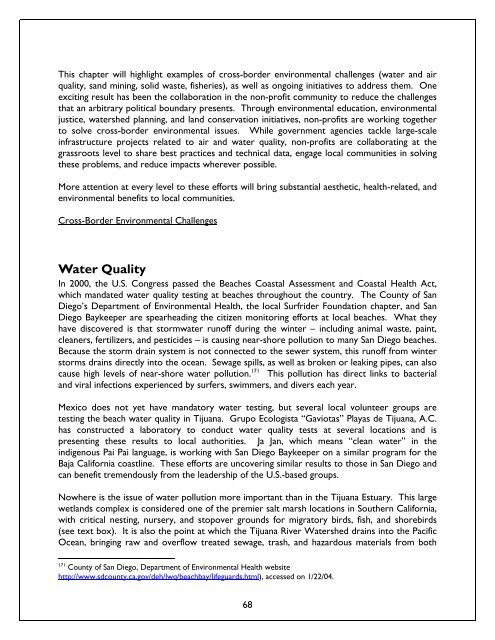Blurred Borders - International Community Foundation
Blurred Borders - International Community Foundation
Blurred Borders - International Community Foundation
Create successful ePaper yourself
Turn your PDF publications into a flip-book with our unique Google optimized e-Paper software.
This chapter will highlight examples of cross-border environmental challenges (water and air<br />
quality, sand mining, solid waste, fisheries), as well as ongoing initiatives to address them. One<br />
exciting result has been the collaboration in the non-profit community to reduce the challenges<br />
that an arbitrary political boundary presents. Through environmental education, environmental<br />
justice, watershed planning, and land conservation initiatives, non-profits are working together<br />
to solve cross-border environmental issues. While government agencies tackle large-scale<br />
infrastructure projects related to air and water quality, non-profits are collaborating at the<br />
grassroots level to share best practices and technical data, engage local communities in solving<br />
these problems, and reduce impacts wherever possible.<br />
More attention at every level to these efforts will bring substantial aesthetic, health-related, and<br />
environmental benefits to local communities.<br />
Cross-Border Environmental Challenges<br />
Water Quality<br />
In 2000, the U.S. Congress passed the Beaches Coastal Assessment and Coastal Health Act,<br />
which mandated water quality testing at beaches throughout the country. The County of San<br />
Diego’s Department of Environmental Health, the local Surfrider <strong>Foundation</strong> chapter, and San<br />
Diego Baykeeper are spearheading the citizen monitoring efforts at local beaches. What they<br />
have discovered is that stormwater runoff during the winter – including animal waste, paint,<br />
cleaners, fertilizers, and pesticides – is causing near-shore pollution to many San Diego beaches.<br />
Because the storm drain system is not connected to the sewer system, this runoff from winter<br />
storms drains directly into the ocean. Sewage spills, as well as broken or leaking pipes, can also<br />
cause high levels of near-shore water pollution. 171 This pollution has direct links to bacterial<br />
and viral infections experienced by surfers, swimmers, and divers each year.<br />
Mexico does not yet have mandatory water testing, but several local volunteer groups are<br />
testing the beach water quality in Tijuana. Grupo Ecologista “Gaviotas” Playas de Tijuana, A.C.<br />
has constructed a laboratory to conduct water quality tests at several locations and is<br />
presenting these results to local authorities. Ja Jan, which means “clean water” in the<br />
indigenous Pai Pai language, is working with San Diego Baykeeper on a similar program for the<br />
Baja California coastline. These efforts are uncovering similar results to those in San Diego and<br />
can benefit tremendously from the leadership of the U.S.-based groups.<br />
Nowhere is the issue of water pollution more important than in the Tijuana Estuary. This large<br />
wetlands complex is considered one of the premier salt marsh locations in Southern California,<br />
with critical nesting, nursery, and stopover grounds for migratory birds, fish, and shorebirds<br />
(see text box). It is also the point at which the Tijuana River Watershed drains into the Pacific<br />
Ocean, bringing raw and overflow treated sewage, trash, and hazardous materials from both<br />
171 County of San Diego, Department of Environmental Health website<br />
http://www.sdcounty.ca.gov/deh/lwq/beachbay/lifeguards.html), accessed on 1/22/04.<br />
68















